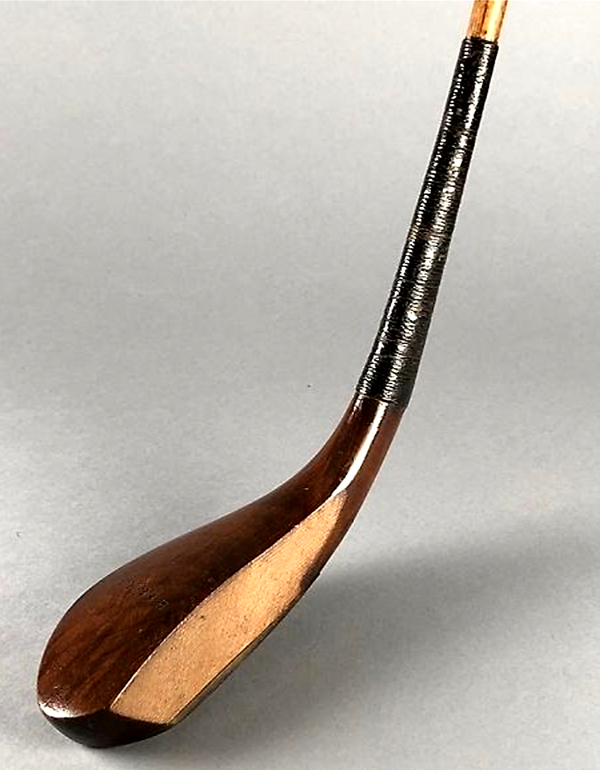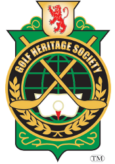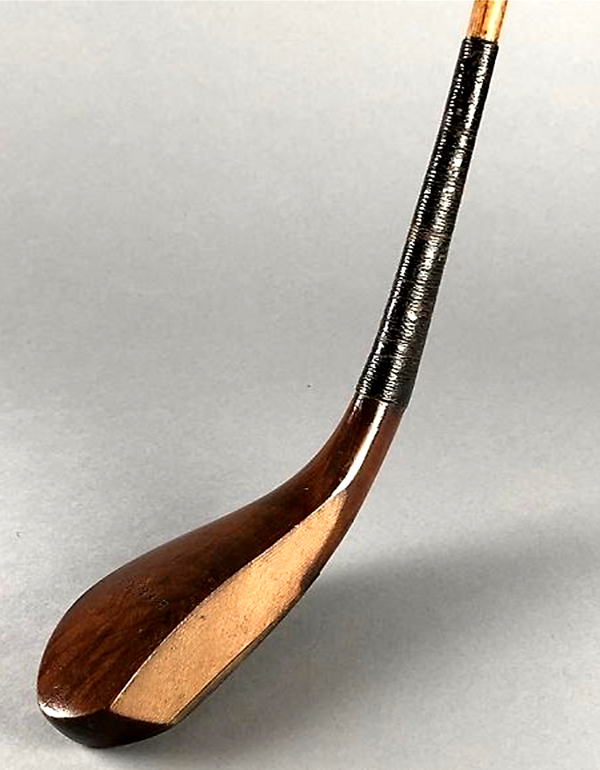
The following article about the legendary club maker Hugh Philp’s work was researched and written by GHS member Jeff Ellis for those who subscribe to his auction service. We reprint it here with his permission as it is rare to see such a club as this. For information about Philp, Dalrymple, Laidlay, and the set of nine mint Philps, click here to visit Jeff’s site and read the description.
By Jeff Ellis
Courtesy Jeff Ellis Golf Auctions
The Hugh Philp long spoon shown above was given in 1887 to Johnny Laidlay by Sir Hew Dalrymple as part of a nine-club set. It is a truly historic and beautiful work of art on many levels. Below you will find people and publications from history speaking to the place of Hugh Philp (b. 1786 – d. 1856) and his hand-crafted artistry in the world of golf. You do not need to be a bidder to appreciate the legacy of the artisan who was Hugh Philp.
“The never-failing fountain of delight!
Here, Mr. Philp, club-maker is as great as Philip—as any minister of state!”
—(George Carnegie, Golfiana, 1842)
“For many and many a year to come, these letters which [Philp] brands on his clubs will serve for Hugh’s best epitaph, and the golfers yet to be will sigh for the ‘touch of that vanished hand’ which fashioned so deftly and so well.”
—(William and Robert Chambers, Chambers Journal, Aug. 6, 1859)
“We may venture to assert, that the best made clubs of modern days, do not excel either in beauty or quality those turned out, thirty years ago, from the workshop of Hugh Philp of St. Andrews.”
—(W&R Chambers, A few Rambling Remarks on Golf With the Rules. 1862)
“Hugh Philp, of St. Andrews—called by Carnegie, in his Golfiana, ‘as great as Philip’—was the most painstaking of all club-makers. No maker of the violin in Cremona devoted more passionate attention to his work than did this framer of ‘ball-compelling clubs.’ “
—(J.G. McPherson, The Scots Observer. April 13, 1889)
“Endowed with an esthetic temperament, Philp had an eye for graceful curves, hence he contrived that his clubs should be invested with artistic merit, which, while not detracting from general usefulness, insured approval as things of beauty, abiding joys, even to the present day. True, his driving clubs would not now be of much practical use to the powerful players representing first-class modern golf. Rolland, the Kirkaldys, Mr. Tait, would snap them like a carrot in addressing the ball; but a Philp putter! That indeed is like wisdom, man knoweth not the price thereof, the gold and the crystal cannot equal it. A few years ago the writer bought for one shilling some half-dozen old clubs that had been stored away as useless lumber; one of them turned out to be an undoubted Philp which subsequently changed hands at £2, and at this moment of writing, another, a play-club, has just been sold for £5. An Old Master, whether of fiddles, pictures, books, or golf clubs, will ever command a price.“
—(H.S.C. Everard, Golf in Theory and Practice. 1896)
“It was Hugh Philp who first departed from these primitive models of the stone age and began to make golf clubs that looked as though they were intended for some gentler work than the crushing in of an enemy’s skull or the manufacture of broken flint for road-building. Philp had an eye for graceful lines and curves, and his slim, elegant models remain to-day things of beauty, though their usefulness has long since departed…. The few specimens that sill exist are acknowledged ‘old masters’ and are only to be exchanged against much fine gold.”
—(Harper’s Weekly, Oct. 2, 1897)
“[Robert Forgan] became golf club maker under Hugh Philp, whose clubs were so famous, and are now esteemed as precious treasures.”
—(St. Andrews Citizen, Feb. 25, 1899)
“[Forgan] was trained to the business by his relative, Hugh Philp, whose clubs now are treasured nearly as dearly as a Cremona violin or Andrea Ferrara sword.”
—(Rev. T.D. Miller, Harper’s Weekly, Vol 43 1899)
“The Prince of putter makers, by common consent, was Hugh Philp, who flourished at St. Andrews more than 50 years ago. This genius made such beautiful and perfect wooden putters that he has come to be regarded as the Amati or Stradivarious of Golf, and a genuine ‘Philp’ to-day is worth untold gold. The long narrow faces of these clubs and their perfect balance are well known to connoisseurs.”
—(Golf Illustrated, Oct. 6, 1900)
“Then arose a great master club-maker, one Hugh Philp by name, who wondrously refined golf-club nature. Slim and elegant, yet, as we of these days would say, of but insufficient power, are the specimens of his art which have descended to us. His true specimens, it should be said; for there is many a club boasting Hugh Philp as its creator which that craftsman never saw—nor can we expect it would have been otherwise, since it is a matter of common report that at least two subsequent club makers had a ‘Hugh Philp’ stamp with which upon the head of the club they would imprint a blatant forgery.”
—(Horace Hutchinson, Golf: The Badminton Library, 1890. Notice the word “blatant,” which means “brazenly obvious”.)
Born in 1859, Horace Hutchinson, quoted directly above, was a two-time British Amateur champion and one of the game’s greatest historians. He grew up in the long nose era and would have known Philp’s work as opposed to a blatant forgery. When it came time to picture and discuss genuine Philp clubs for one of his books, after warning of blatant fakes in one of his earlier books, Hutchison chose the nine Laidlay Philps. And understandably so.
Just look at the above descriptions and then look at the Laidlay Philp above and at my auction. It is difficult to imagine a more beautiful elegant, graceful, and artistic club. No wonder the nine Laidlay Philps were put on display at the Glasgow Exhibition of 1901, which celebrated all things Scottish in the manner of a World’s Fair. To me, as someone who has owned two Laidlay Philps and handled four others, all nine of them are the pinnacle of clubmaking craftsmanship. Rivaled? Sure. But exceeded? Nope.
Two more quotes from Horace Hutchinson:
“[Hugh Philp’s clubs] were beautiful specimens of art, finely finished, elegant, long-headed things…. The late Sir Hew Dalrymple had a very perfect set that he gave to Mr. J.E. Laidlay.”
—(Horace Hutchinson, The Book of Golf and Golfers, 1900)
“I have been looking over, not for the first time, a set of clubs, all of the manufacture of the famous Hugh Philp, which were given by the late Sir Hew Dalrymple, at his death, to Mr. J.E Laidlay.”
—(Horace Hutchinson and Bermard Darwin, Country Life, 1913 vol 33)

